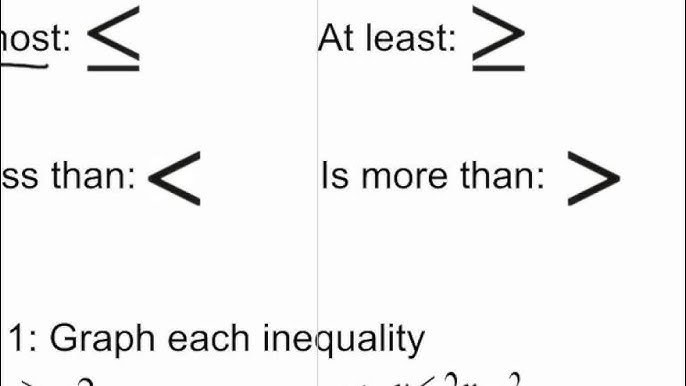The ‘at least inequality sign’ indicates a value that is equal to or greater than the stated quantity. Understanding how to use this mathematical symbol correctly is essential in various algebraic expressions and equations. It is a versatile tool that helps establish relationships between numbers and variables, guiding us in making comparisons and drawing conclusions. By mastering the at least inequality sign, we unlock the ability to analyze data systematically and solve complex mathematical problems effectively. Let’s delve deeper into the significance and practical applications of this essential symbol in mathematics.
The Amazing At Least Inequality Sign: What Does It Mean?
Welcome, young mathematicians! Today, we are going to dive into the fascinating world of math and explore the “at least” inequality sign. Have you ever wondered what those signs that look like crooked mouths (<) and big Vs (>) mean? Well, get ready to find out!
Understanding the At Least Inequality Sign
Let’s start with the basics. The at least inequality sign is used to compare numbers and show which one is bigger. The sign that looks like a crooked mouth (<) means "less than," and the big V symbol (>) means “greater than.” But what about the at least sign? This special symbol looks like a greater than sign with a line underneath it (≥). Can you guess what it means?
At Least vs. Greater Than
When we see the at least inequality sign (≥), it tells us that the number on the left is at least as big as the number on the right. It’s like saying, “I want at least three cookies,” which means you won’t be satisfied with just two. In math, it works the same way!
Practical Examples
Let’s look at some real-world examples to understand how the at least inequality sign works. Imagine you have a collection of colorful marbles. If you say that you have at least five marbles, it means you might have five, six, seven, or even more marbles. As long as you have five or more marbles, the statement holds true.
Number Line Adventures
Another way to visualize the at least inequality sign is by using a number line. Picture a line with numbers from 0 to 10. If we have an inequality like 3 ≥ 2, you can shade in all the numbers from 3 up to 10, including 3. This shows that 3 is at least as big as 2.
Using the At Least Inequality Sign in Math Problems
Now that you understand what the at least inequality sign means, let’s explore how we can use it to solve math problems. Imagine you have an equation like 7 + n ≥ 10. To find the value of n, we need to figure out which number, when added to 7, will give us a sum that is at least 10. Can you solve it?
Solving Equations with the At Least Sign
To solve the equation 7 + n ≥ 10, we need to subtract 7 from both sides to isolate n. This gives us n ≥ 3. So, any number equal to or greater than 3 will make the inequality true. You can test different numbers to see which ones work!
Challenges and Fun Activities
Math can be exciting and challenging at the same time. How about we try a fun activity to test your understanding of the at least inequality sign?
Activity: Marbles Galore!
Imagine you have a bag of marbles. Your friend tells you that you have at least eight marbles. How many different numbers of marbles could you have in your bag that would still make your friend’s statement true? Grab some paper and pencils and start exploring!
Keep practicing and playing with numbers to master the world of math. The at least inequality sign is just one of the many exciting tools you have in your mathematical toolkit. Have fun exploring and discovering new ways to use math in your everyday life!
✅✅Symbols of Inequality #Inequalities #math #algebra
Frequently Asked Questions
What is an inequality sign used for in mathematics?
An inequality sign is used to compare two quantities, showing the relationship between them. It indicates whether one quantity is less than, greater than, less than or equal to, or greater than or equal to the other.
How do you read and interpret the “less than” inequality sign (<) in mathematics?
The “less than” inequality sign (<) indicates that the quantity on the left is smaller than the quantity on the right. For example, 5 < 10 means that 5 is less than 10.
Can you explain the meaning of the “greater than or equal to” inequality sign (≥)?
The “greater than or equal to” inequality sign (≥) signifies that the quantity on the left is greater than or equal to the quantity on the right. For instance, 8 ≥ 6 means that 8 is greater than or equal to 6.
Final Thoughts
In conclusion, bridging the wealth gap is a pressing issue that needs urgent attention. Governments and businesses must take action to address economic disparities. It is crucial to implement policies and initiatives that promote equality across all sectors. Let’s work together towards a future where no one is left behind, striving for a society where the inequality sign is gradually diminished.



